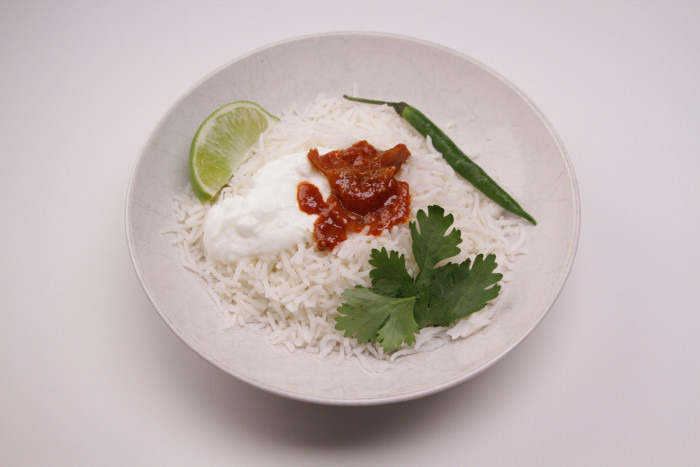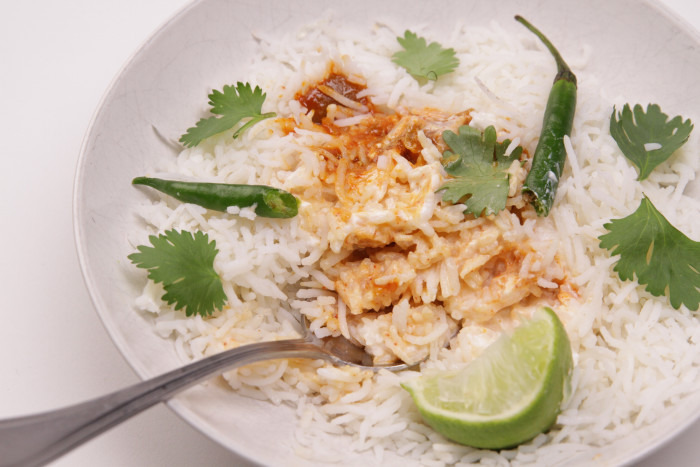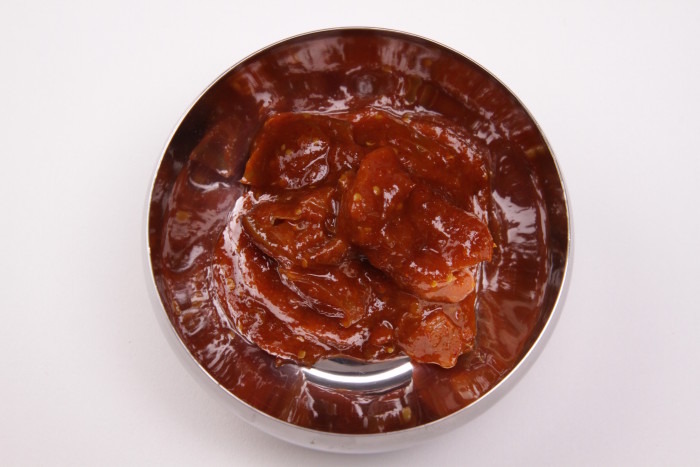Indian Pickle Is The Greatest Condiment On The Subcontinent
Condiment of the Week is your place to find and demystify the latest, greatest sauces, pastes, pickles, mustards, goops, blends and sprinklables on the planet. The best ones have been around forever; you just didn't know about them. Indian pickle, otherwise known as achar, is one of those things. Steam up a pot of basmati and grab some yogurt — we're hitting the subcontinent hard.
Any food writer encounters the following question: "What's your favorite food?" No food writer should have an answer at the ready. I certainly don't — never have. I couldn't possibly. I do have a favorite condiment, though: the mustard-cured Indian pickles known as achar, or simply "pickle." As one would with most beloved condiments, I use it to make a very simple thing burst with flavor. French fries don't burst with flavor all on their own, but dunk one in ketchup, Dijon or mayo (depending on where in the world you are) and watch that whole fried pile disappear. We're not talking about fries, though. We're talking about rice, the undisputed king of the subcontinent. Now let's talk subcondiments.
Basmati rice mixed with yogurt is India's answer to Asian congee/juk, British mash or any bare-bones starch or grain-based, porridge-type sustenance dish. Sometimes lentils are involved, and sometimes this humble mixture is it. It's frequently infants' first solid food. Indians from the western state of Gujarat eat rice and yogurt following a meal as a kind of digestif. Delicious and fortifying as fragrant, earthy basmati and tangy, fresh, probiotic- and protein-rich yogurt may be by themselves or together, some would say it's missing a certain something, and that something is a tangy, pungent, mustard oil-cured fruit or vegetable.


Like kimchi in Korea, pickle is traditionally made by "aunties" working together when the summer goods are ready. Sour, firm green mangos, backyard garden-plot carrots and small, thin-skinned, overabundant limes and other readily available produce are prime candidates. They're harvested, coated in mustard oil and a complex blend of spices (both of which inhibit the growth of bacteria) and left to cure until tender in the relentless pre-monsoon sun.
So why aren't you seeing pickle on menus other than Indian ones? Like many popular ethnic condiments — Filipino bagoong or Vegemite, for example — it takes the palate more than a few times to adapt to what may feel at first like all-out taste bud assault. New York City–based Indian chef Aliya Leekong has a theory:
"Fermentation and pickling and preservation are really current topics; you see it in different forms everywhere," she says. "Brininess is so important to Western food — capers, olives, mignonette on top of oysters. You're always seeing that acidic flavor profile. The difference in pickle and achar is that you're brining it in pungent oil instead of tart vinegar. That maybe changes the likability."
Michelin-starred Indian chef Hemant Mathur is optimistic that pickle is gaining a foothold in the American palate. "Pickle is not very popular in the States yet — it's a strong flavor," he says. "Lots of Americans travel to India, taste pickle, then come back and enjoy it more. I think the mustard oil flavor is very strong to an American palate, but slowly very good-quality mustard oil is being used when preparing it, which makes it much better."

Leekong uses carrot pickle as a fusion element in a number of ways, like processed into a paste and dolloped sparingly on oysters or blended with Greek yogurt and pickled shallots and served as a dip for carrot crudité (or "carrots two ways," as she calls it). "Think of a tartar sauce that has cornichons and capers, or just imagine a really good fried-fish sandwich with mango pickle mixed with yogurt or mayo."
But at the end of the day, the way you'll see this staple of Indian cuisine enjoyed by its natives is very simply, with plain rice.
"I want to eat pickle with rice and yogurt," admits Leekong. "I can't eat rice anymore without some pickled element. We ordered Chinese the other night, and it needed more acid, so I grabbed a jar of pickle out of the fridge. My husband was like, 'What are you doing?' I have an inherent pickle need for rice dishes."
Mathur concurs. "I like simple homemade lentils, roti or chapati and pickle," he says, of his preferred method of consumption. His advice on tackling this potentially intimidating flavor explosion at home: the deceptively simple achari chicken tikka."Grind mango pickle and lime pickle together into a paste, rub it on chicken and cook on skewers on the grill." Serve with...you guessed it, rice, yogurt, chilis and coriander. Maybe a squeeze of lime for good measure.

